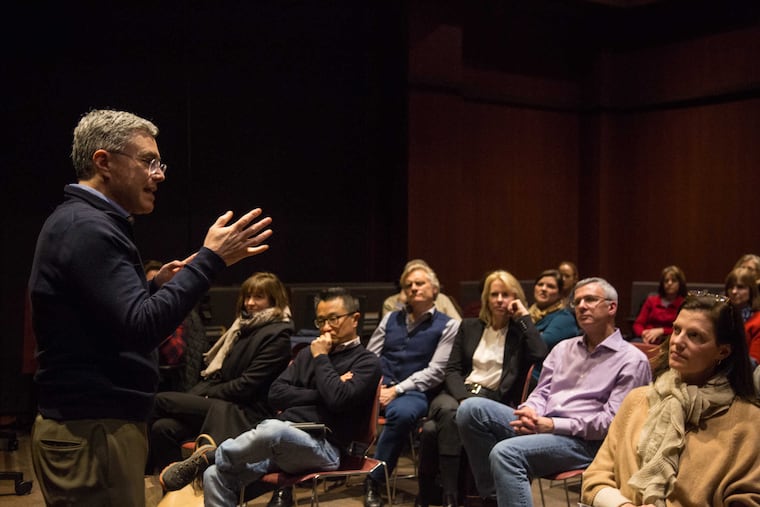A guide is helpful when learning to meditate for stress reduction

For many of us in this frenetic, disturbing world, the idea of sitting still for a while and clearing our heads in silence sounds delicious. That such meditation has myriad health benefits is a bonus.
Then we try it on our own. Three minutes seem like an eternity. We find that focusing on our breath is boring. Our unruly minds race to soccer practice, the broken muffler, the looming layoffs at work, Mom's cancer, the dog's walk, dinner, or a million other things we could be doing or worrying about. Those of us who need it most may reasonably conclude that meditation is not a DIY activity. We might be right.
Michael Baime, a primary-care doctor who directs the Penn Program for Mindfulness, is a good person to ask about how to start meditating. His program offers a very popular eight-week course — 27 hours for $569 — that has trained more than 17,000 people in the Philadelphia region. Baime, who started trying to meditate on his own as a child, said most people he knows who do it successfully eventually got some outside help.
Meditation can help people undo a lifetime of unhelpful habits: the way we think, feel, and hold stress in our bodies. That takes time and work, just like learning to play the piano or ice skate, Baime said. "It's not that easy."
It's not even easy to figure out what meditation is. Just try Googling a definition. Is it breathing in a special way, chanting, relaxing, staring at a candle, thinking, not thinking? Baime said that mindfulness, which is often used to manage stress, is just one form of meditation, a kind of mental discipline that has been used for centuries to still and focus the brain. Mindfulness often uses breath or physical sensations to help practitioners more fully experience the present.
People are often disappointed, Baime said, because they think that meditation itself is a pleasurable experience, that it will feel blissful. That's not the case, he said. It can be hard, boring, and frustrating. It's not like practicing the multiplication tables. You learn them. You're done. It's more like practicing yoga. There's always a way to do a pose better, and there's always another pose. It's really about learning to accept imperfection and discomfort.
When practiced, Baime said, meditation helps people notice their thoughts and feelings before they're so angry or upset that they do something that adds to their stress. They also learn to savor and appreciate the good things in their lives. The world seems more beautiful. Relationships are stronger. The bliss flows from that.
"Ultimately," Baime said, "the reason why it's so beneficial to people is that it enhances their experience of depth, meaning, and connection in their life. In fact, that's the best antidote to stress."
Sometimes it seems as if the goal of meditation is to calm people and help them cope with difficult circumstances. What it actually does for some people, he said, is give them the strength and clarity to change.
It is natural to wonder, he said, why we would want to be more fully present when our "now" is stressful and painful. The reason, he said, is that stress is "affecting your whole biology and cognition in a way that is not helpful. When you really notice it clearly, it stops running the show." The same is true of uncomfortable emotions, such as fear. If you learn to tolerate them instead of trying to control them or push them away, they start to fade.
So, how do you do this? Baime said there are no rules — or scientific evidence — about how long you should practice, although he recommends doing it regularly. People who take his class are asked to practice 40 minutes a day during the eight-week period. "If three minutes is what you have, then three minutes is what you do," he said. "Three minutes is definitely better than nothing."
You can meditate in any position, but Baime said there is some evidence that sitting upright with a well-aligned spine works best.
If you think reading will help, Baime recommended Full Catastrophe Living by Jon Kabat-Zinn, the founder of mindfulness-based stress reduction, and workbooks by Bob Stahl, also an authority on the technique. He said many people find it easier to start with guided meditation tapes in which someone else tells you what to do. The real work, though, is in the part where no one is talking.
If you want to try it on your own, start out slowly. Do maybe five minutes a day. When that starts to feel comfortable, try 10.
Just sit quietly and observe your breath. That's it. When your mind wanders — and it will — notice that without judgment, and go back to observing the breath. "Remember that you noticed, and that's the whole point of it," Baime said.
He recently guided participants in an introductory class in Radnor through a meditation focused on bodily sensations. The idea was to start with the forehead and slowly move through the body while observing how each part felt. Did inhaled air feel cooler in the nostrils than exhaled air? How about those tight muscles at the base of the neck? The trick was to notice discomfort, stick with it, and see how the feelings changed. You can breathe deeply and see how that feels, or you can just breathe normally. Baime says the breaths will naturally become slower and more even over time.
Try it a while. And then you might want to take a class. To find one, you can do an internet search for classes near your home or work zip code.